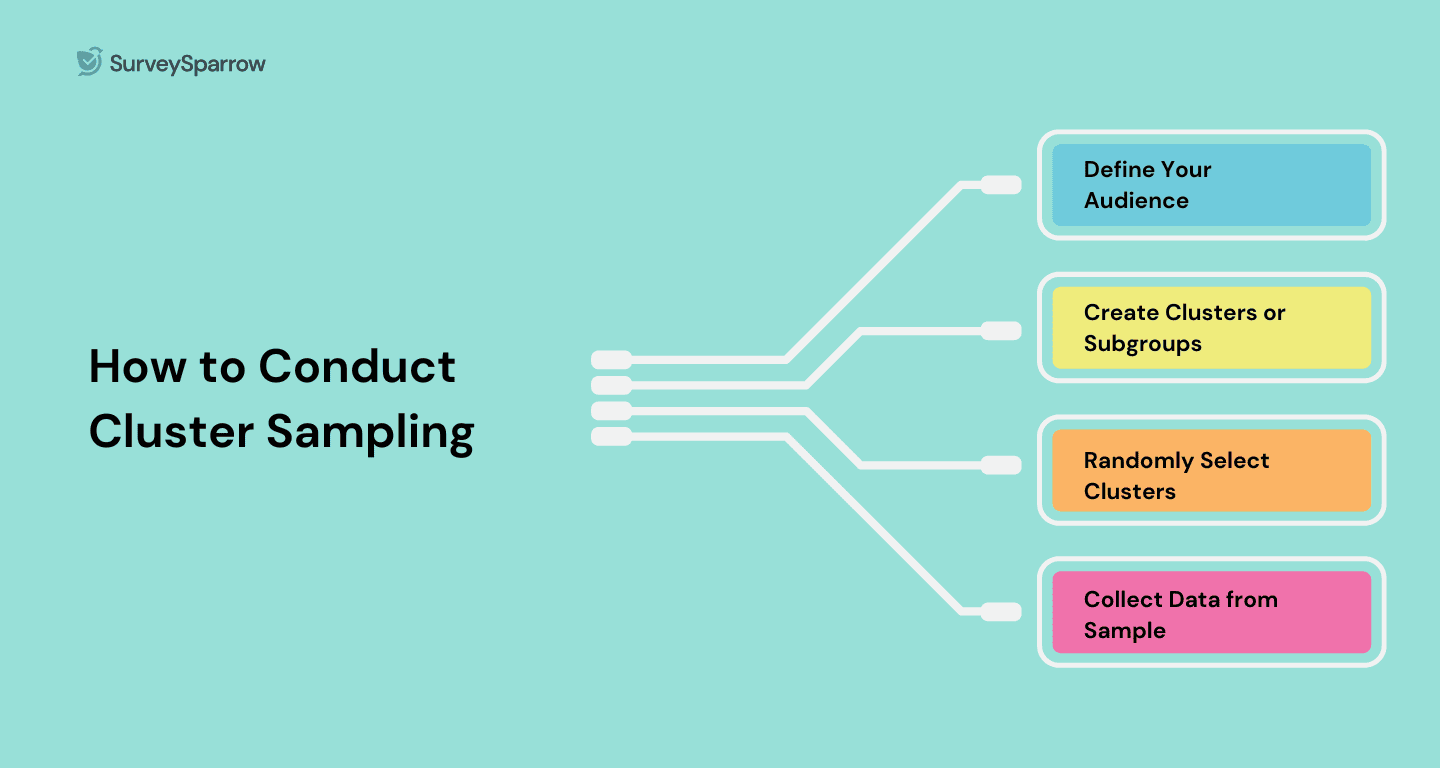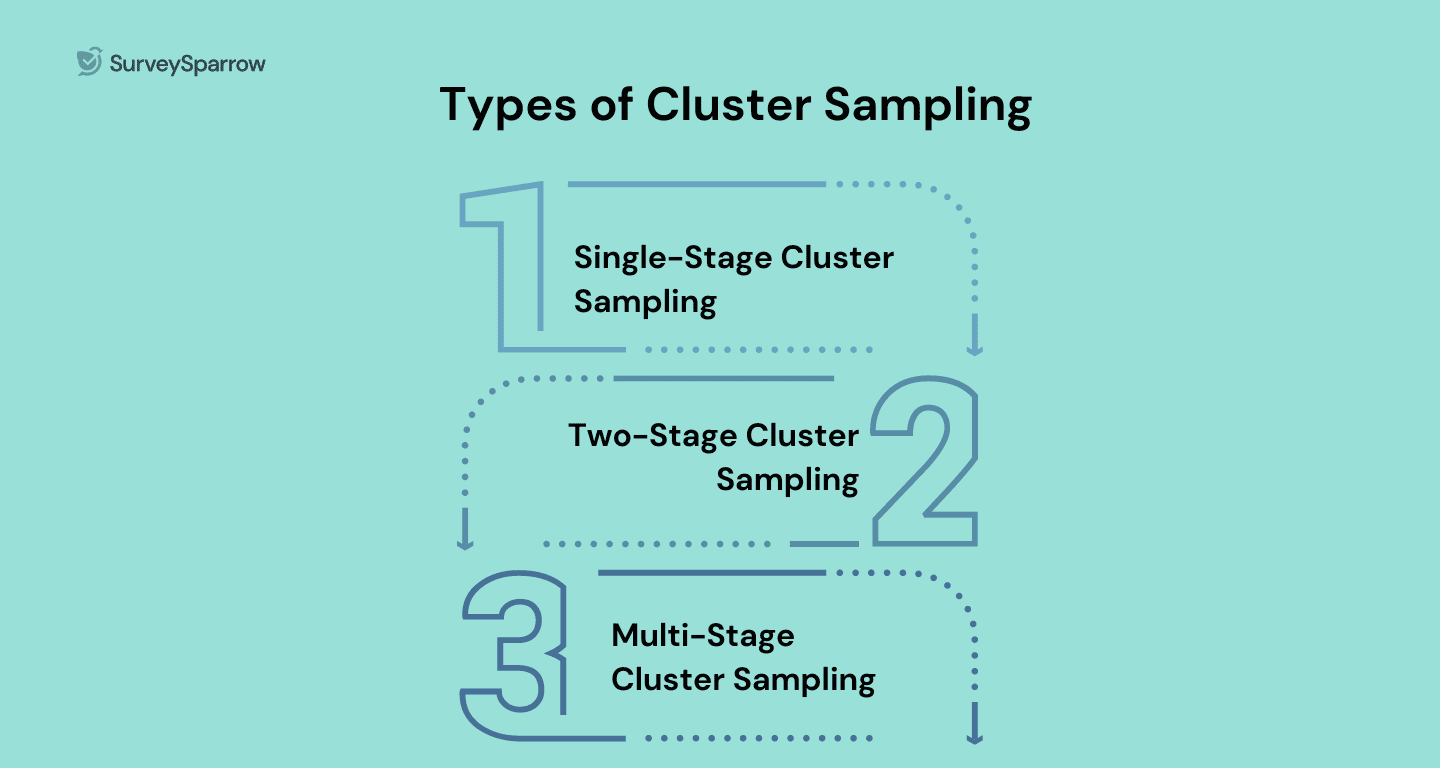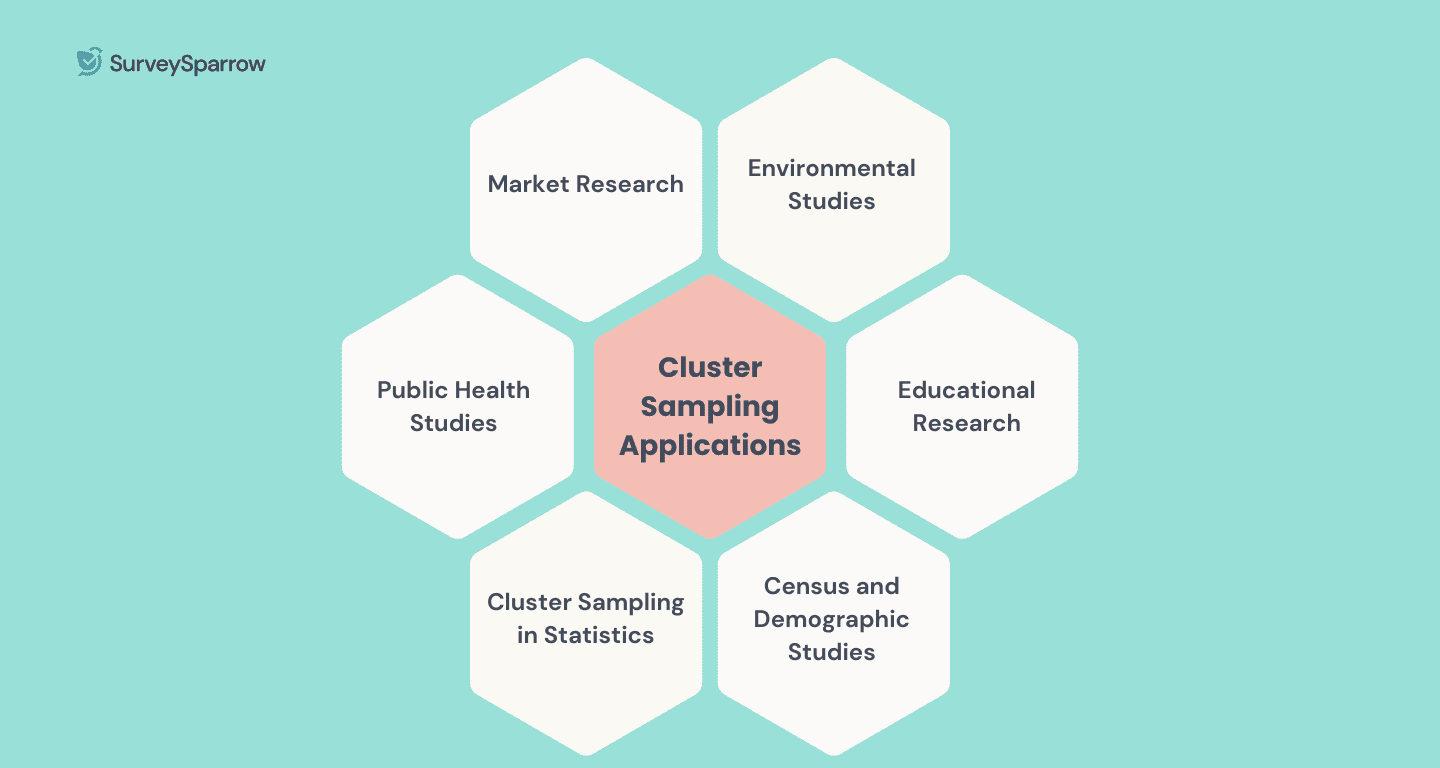Survey & Feedback
Cluster Sampling: A Comprehensive 4-Step Guide with Examples
Article written by Pragadeesh Natarajan
pragadeesh
13 min read
19 September 2025

60-Sec Summary:
Cluster Sampling: What You Need to Know
- Efficient Data Collection: You can save time and cut costs by dividing your large audience into clusters and randomly selecting a few to survey—no need to reach everyone.
- Simple Implementation: Cluster sampling is easier to execute than many other methods, letting you focus resources where they matter most.
- Flexible Approaches: Choose from single-stage (survey all in selected clusters), two-stage (survey random individuals within clusters), or multi-stage sampling to fit your project’s complexity.
- Wide Applications: Perfect for market research, public health insights, education assessments, and large-scale surveys like censuses.
- Be Cautious: Ensure your clusters truly represent your entire population to avoid skewed results and high sampling errors.
- Maximize Engagement: Boost data quality by using conversational surveys that keep respondents involved and honest.
Cluster sampling in statistics allows you to collect the right representative data from a large target audience. Collecting accurate data from a large population is hard, and this is where cluster sampling comes in to ease things up.
Here’s what we’ll cover about the topic. Feel free to jump to a relevant section:
- What is cluster sampling?
- How to conduct cluster sampling
- Types of cluster sampling
- Applications of cluster sampling
- Advantages and disadvantages of cluster sampling
- Common Pitfalls
- Wrapping up
What is Cluster Sampling?
Cluster sampling is a probability sampling technique where the large target group is divided into multiple smaller groups or clusters for research purposes. Researchers then form a sample by randomly selecting these clusters.
The random selection gives every group in that target population an equal chance to be a part of the sample group. However, only a few relevant groups were selected, and the rest were eliminated.
Wondering when to use cluster sampling? We use a cluster sample to study large populations. Typically, clusters are obtained from pre-existing groups such as schools or cities.
Then, we group the samples together by certain shared characteristics or attributes. Samples include multiple attributes such as demographics, goals, habits, backgrounds, etc.
Providing more attributes helps you accurately target the right group that could give you accurate feedback. Instead of selecting the entire population, researchers pick a smaller, more productive group within that population to research and collect data
Cluster Sampling Example
If you’re looking to conduct a survey on the performance of smartphones in the United States, you can divide America’s population into certain popular cities such as New York or Los Angeles.
You can then target those individuals who own smartphones in the respective cities and who use a certain kind of mobile OS. All of the above are valid attributes that would help you target the right group of people to research.
Cluster Sampling Example
If you’re looking to conduct a survey on the performance of smartphones in the United States, you can divide America’s population into certain popular cities such as New York or Los Angeles.
You can then target those individuals who own smartphones in the respective cities and who use a certain kind of mobile OS. All of the above are valid attributes that would help you target the right group of people to research.
Complete 4-Step Guide to Implement Cluster Sampling
Here’s how to conduct single-stage cluster sampling and find the correct representative sample:

Step 1: Define Your Audience
Before implementing cluster sampling, you need a clear understanding of:
Who or what you’re studying: Define your target population’s boundaries, characteristics, and scope
What you aim to discover: Clarify your research questions and objectives
Which variables are crucial: Identify key metrics and variables for measurement
Checklist for proper population definition:
Geographic boundaries clearly established
Temporal limitations specified (if applicable)
Inclusion/exclusion criteria defined
Population size estimated
Based on this, decide on your target population and desired sample size.
Example from market research: A food delivery app studying customer satisfaction might define their population as “all active users who placed at least one order in the past 3 months across all service areas."
Step 2: Create Clusters or Subgroups
Now, divide your target population into smaller subgroups or clusters based on specific criteria. Getting this step right is crucial as it affects the quality of your segment or cluster and how well it represents your target population.
Criteria for effective cluster formation:
Each cluster should be a small epresentation of the overall population
Clusters should be mutually exclusive (no overlap)
Clusters should be collectively exhaustive (covering the entire population)
Clusters should be relatively equal in size
Natural boundaries or groupings are ideal when available
Random selection techniques:
Simple random sampling of clusters using random number generation
Systematic sampling with a randomly selected starting point
Probability proportional to size (PPS) sampling, where larger clusters have higher selection probabilities
Example: A nationwide educational assessment might use school districts as natural clusters, randomly selecting 50 districts from across the country using a random number generator mapped to a complete list of districts.
Step 3: Randomly Select Your Clusters
Once clusters are selected, you must decide how to sample units within them:
Decision factors between sampling all units vs. subsampling:
Available resources (budget, time, personnel)
Required precision level
Cluster size variability
Logistical constraints
Data collection method
Example: After selecting 30 neighborhoods in a city, researchers might determine they need to sample 20 households from each neighborhood based on their budget constraints and required confidence level.
Step 4: Collect Data from the Sample
Finally, conduct your research and collect data from your selected clusters.
Data collection best practices:
Standardize your protocols across all clusters
Train data collectors consistently
Document cluster and unit selection process
Maintain detailed records of your response rates
Implement quality control measures
Analysis considerations specific to cluster samples:
Account for the cluster design in your statistical analysis
Use specialized software that handles cluster sampling (e.g., SPSS Complex Samples, Stata survey commands)
Report intraclass correlation coefficients
Calculate and report design effects
Consider weighting adjustments if needed
Example: When analyzing survey results from a clustered sample of hospital patients, researchers would use specialized software to account for potential correlations among patients within the same hospital, ensuring accurate confidence intervals and significance tests.

Maximize Your Survey Data with AI!
A personalized walkthrough by our experts. No strings attached!
3 Types of Cluster Sampling
There are mainly 3 types of cluster sampling you should know about. They are as follows.

1. Single-Stage Cluster Sampling
In single-stage cluster sampling, entire clusters are randomly selected. And for the data, it's collected from every member within those selected clusters. This method is efficient when the population is geographically dispersed.
How it works:
Divide the population into clusters
Randomly select a subset of clusters
Include all units from the selected clusters in your sample
For example, suppose a researcher wants to study a population across several states. In this case, they might randomly select a few states and survey all individuals within those states.
2. Two-Stage Cluster Sampling
Two-stage cluster sampling involves two levels of selection. Firstly, the researchers randomly select clusters, and then they randomly select individuals within them. This method allows for a more manageable sample size while still providing a representative sample.
How it works:
Divide the population into clusters
Randomly select a subset of clusters
Within each selected cluster, randomly select individual units
For instance, a study might first choose several cities, and then randomly select households within those cities to survey.
3. Multi-Stage Cluster Sampling
As the name indicates, it allows for multiple levels of clustering. Researchers may first select large clusters, then smaller sub-clusters with those. This process continues until it reaches a manageable sample size.
How it works:
Divide the population into primary clusters
Randomly select primary clusters
Divide selected primary clusters into secondary clusters
Randomly select secondary clusters
Continue this process for as many stages as needed
Sample final units from the last stage of clusters
Multi-stage cluster sampling is particularly useful for populations with a hierarchical structure. For example, a study randomly selected countries, then the states, and then the villages within the countries.
6 Major Applications of Cluster Sampling
Here are some common applications of cluster sampling.

1. Market Research
Cluster sampling is frequently employed in market research. It's used to collect customer insights from specific geographical regions. By focusing on selected clusters, businesses can efficiently assess customer preferences, satisfaction, and more. All of this is possible without the need to survey the entire market.
2. Public Health Studies
In public health, this sampling method is used for rapid assessments of community health behaviors and needs.
For example, researchers might divide a city first into neighborhoods (clusters). Afterward, they randomly select some to survey about health practices, vaccination rates, or disease prevalence. This is highly helpful in emergencies or resource-limited settings where complete data collection is impossible.
For an efficient way to conduct health-related surveys within selected clusters, check out SurveySparrow’s Healthcare Survey Templates. These ready-to-use forms can help streamline your data collection process in public health studies.
3. Educational Research
Educational studies often utilize cluster sampling to evaluate interventions or programs within schools.
The clusters here are the schools. So, researchers will start by selecting the schools and then survey all students. This way, they can gather insights into educational outcomes. A tailored one can collect the effectiveness of teaching methods across different demographics.
4. Environmental Studies
Cluster sampling is used here to assess ecological data across large areas. Here, the clusters are specific regions or habitats. The researchers can gather data on biodiversity, pollution levels, or resource usage without the need to survey the entire ecosystem.
5. Census and Demographic Studies
Another area where cluster sampling is often applied is in demographic surveys and censuses. By selecting clusters of households or individuals, statisticians can estimate population characteristics and trends.
6. Cluster Sampling in Statistics
Statisticians use clusters as a practical sampling method for research. For instance, you use it during a natural disaster as it is totally impractical to collect data from every single person affected by the disaster.

Maximize Your Survey Data with AI!
A personalized walkthrough by our experts. No strings attached!
Advantages and Disadvantages of Cluster Sampling
Like every other sampling method, cluster sampling also has its advantages and disadvantages. Let's have a look at them.
Advantages of Cluster Sampling
1. Time and cost-efficient:
Collecting data from a smaller number of people is more time and cost-efficient than collecting data from the target population as a whole.
2. Easy to implement
Compared to other probability sampling methods, a cluster sample is relatively easy to implement in practical situations.
3. High reliability
It can get you reliable, valid results when your target population is clustered properly.
Disadvantages of Cluster Sampling
1. Imprecise results
When you fail to put together groups that closely resemble your desired population, you’ll get results that aren’t accurate.
2. Difficult to analyze
It can become quite difficult to analyze when you’re dealing with different segments of people or clusters and their characteristics or attributes.
3. High sampling error
Cluster samples can be prone to high sampling error when not done right.
Common Mistakes to Avoid in Cluster Sampling
Even those experienced researchers can make errors when implementing cluster sampling. Being aware of these common pitfalls can help you avoid them:
1. Creating Homogeneous Clusters
Clusters that are too similar internally defeat the purpose of cluster sampling, which assumes each cluster is a mini-representation of the whole population.
Solution: Ensure clusters are formed based on characteristics unrelated to what you’re measuring. For example, if studying income levels, don’t create clusters based on neighborhood affluence.
2. Selecting Too Few Clusters
Choosing too few clusters increases sampling error and reduces representativeness.
Solution: It’s generally better to select more clusters and fewer units within each cluster than the reverse. Aim for at least 30 clusters when possible.
3. Ignoring Cluster Effects in Analysis
Analyzing cluster sample data as if it were a simple random sample leads to underestimated standard errors and inflated significance.
Solution: Use statistical software and methods specifically designed for analyzing clustered data, such as multilevel modeling or survey procedures that account for complex sampling.
4. Inadequate Documentation
Poor documentation of the sampling process makes it difficult to assess the quality of the sample or replicate the study.
Solution: Maintain detailed records of:
How clusters were defined and created
The selection process for clusters and units
Response rates at each level
Any deviations from the original sampling plan
Expert tip: Create a sampling protocol document before beginning your study to ensure consistency throughout the process.
Final thoughts
In order to conduct an effective one, you need to come up with characteristics or attributes that accurately represent your target audience. Once you’ve nailed this part, it gets a lot easier to collect data that’s accurate and resembles the opinions of your target population.
Are you looking to use surveys to collect data from your selected clusters? SurveySparrow provides you with everything you need to create and conduct conversational surveys that your audience will love answering!
Conversational surveys typically tend to boost survey responses and create pleasant experiences that your customers will appreciate.
Most of your customers will complete your survey as they would be pleased to take surveys that are conversational in nature and are quite different from the long, boring forms you’ve seen on the internet.
Also, SurveySparrow provides you with a simple drag-and-drop interface and premade templates that anyone can use to create conversational surveys in minutes without having to start from scratch.
If you’re looking to boost your survey responses and create pleasant experiences, take the conversational way and try SurveySparrow today!
Have you got any questions on cluster analysis? Any interesting tips or hacks for conducting effective cluster analysis? Let us know in the comment section below.
If you’re wondering whether SurveySparrow is the right fit for you and would rather have someone walk you through our platform, reach out to us for a free, personalized demo!
Or sign up and try it out for free!
14-day free trial • Cancel Anytime • No Credit Card Required • No Strings Attached

Create engaging surveys that people actually complete. Try SurveySparrow now!
Pragadeesh Natarajan
I'm a developer turned marketer, working as a Product Marketer at SurveySparrow — A survey tool that lets anyone create beautiful, conversational surveys people love to answer.
Frequently Asked Questions (FAQs)
It is a research approach that splits the target audience into multiple smaller groups or clusters to better target and collect accurate data.
There are three distinct types: single-stage, two-stage, and multi-stage. You can collect data from every unit (single-stage) or a random sample of units (multi-stage) within the selected clusters.
It is time and cost-efficient, especially when targeting large samples. However, it provides average results as it is difficult to ensure that your clusters closely represent your target population as a whole.
Related Articles

Survey & Feedback
The A to Z Of Course Evaluation Surveys
14 MINUTES
3 April 2021

Survey & Feedback
The Beginner's Guide to Market Research Surveys
13 MINUTES
29 May 2018

Survey & Feedback
100+ Fun Poll Questions For Every Occasion
13 MINUTES
31 October 2022

Survey & Feedback
What is Turf Analysis: Importance and Applications in Market Research
10 MINUTES
28 April 2023
